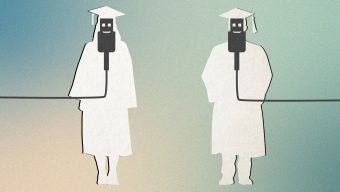Each incoming university class, regardless of campus location or program specialization, arrives with its own set of distinctions. Some freshman enter at a time of high unemployment rates only to graduate with multiple job offers while others learn to create opportunities for themselves and begin a new wave of entrepreneurship. There is no question, of course, that two years ago, students faced yet another distinction – an obstacle – and perhaps one of its largest and most transforming in a generation. The pandemic upended traditional forms of higher education and, in a matter of weeks, universities around the world transitioned to a completely online format in order to follow national regulations and lockdowns.
Academics and university administrators have much to say about all of this, which is valid given their experience and expertise. However, there is another important group to weigh in on this conversation about how the pandemic has changed higher education: the students. How do university students think their own education experience has changed due to the health crisis? What do students believe these changes mean for their future?
A survey led by The Stork, the student-run online newspaper of IE University, where I recently served as editor, investigated varying opinions regarding changes in higher education, and prospects for its future. We did this in partnership with the student newspapers Roar News of King’s College, Ubyssey of the University of British Columbia, and Outlook of the American University of Beirut. The surveys, tailored by each newspaper for their particular student body, were a compilation of interviews, online polling, and academic journals that have early quantitative research on student public opinion.
The results portray three key areas of concern for students during this time of transformation: teaching, learning, and living. When asked about expectations and experiences, students were most interested in how universities respond to their different needs when it comes to teaching styles, the new flexibilities of learning, and on-campus living. At the end of the day, the ability to tap into the needs of students and respond to them in dynamic, innovative, and character-shaping ways is what connects these three areas, and what will set apart each university from the next. This is not to say that every university must follow an identical model of management or pedagogy, but should carry a similar goal of sensibility and responsiveness.
Students overwhelmingly believe that when instructors teach online, they must evolve their syllabus.
Before the pandemic, teaching course material online was not yet a reality for many universities, but it quickly became one. As noted during the most recent Reinventing Higher Education Conference hosted by IE University and Luiss University in Rome, pedagogical innovation is key to keeping students engaged with their coursework and future careers. Recorded lectures, in-person discussions, and hybrid co-lecturing with experts abroad (which students particularly appreciate by the way), are all ways in which educators can begin to shape the future of learning and create a new and better “normal.”
As a fourth-year International Relations student, I’ve had the liberty to take several electives and pursue my interests outside of IR, such as a class on Art: the Social and Business perspective. Now, I am neither an artist nor a business woman, so this class is fairly outside my comfort zone. It is also a class that is conducted completely online. During lectures, we signed in to the platform and learned from the professor about art evaluation, exhibits, selling and buying, and more. Despite the format, however, the learning was not confined solely to the online world. For example, our assignments included going to an art auction house in Madrid to see firsthand how the worlds of art and business coincide. It is exciting that this is the type of activity equivalent to the lecture hall.
Asynchronous sessions are a reality for a variety of fields across many universities now. In short, students surveyed by The Stork report that they ‘seek holistic literacy on how to tackle 21st-century issues, be it the next pandemic, climate event, or political crisis’. As IE University President Santiago Iñiguez recently wrote, not only teaching students about how the world is but challenging them to think about how it should be.
Students overwhelmingly believe that when instructors teach online, they must evolve their syllabus and place more emphasis on pedagogy. Some people argue that students don’t like online learning. This is not true. Teaching is not only about format, it is about engagement. Students are inspired by those who want to teach them something new, who deposit knowledge into their lives.
Among the points that stood out in the student survey responses were the importance of technology, the hybrid model, connectivity, as well attention to mental health. These may well be intimidating topics to tackle. From infrastructure constraints to notions that students might not set foot on campus again, the reality is that the hybrid classroom is here to stay. Technological infrastructure enables students to enjoy the fruits of their investment wherever they are. The likes of delayed visa processes, political crises, and reduced mobility no longer have to be direct obstacles to the attainment of higher education. Technology opens education and the university environment to more students to be able to enjoy and enrich the university environment. Connectivity and responsiveness go hand in hand and, in fact, student newspapers play an important large role in bridging the gap between the university administration and the student body.
Increasingly, students plead that we bridge the disconnect between business management in higher education and the human needs of students. One of these pressing needs is particularly important: attention to mental health. The Ubyssey student newspaper reported that students feel stressed and face the possibility of burnout at a young age. Universities should not only respond to pedagogical needs, but personal ones. UCB told us that they “hope that the future of higher education is more understanding, accommodating, and provides students with real options in times of crisis,” like accommodations through hybrid learning and increased connectivity with their faculty.
According to The Stork polls, 91% of student respondents think the pandemic has changed higher education forever; 97% think that students should be marked with attendance when participating in class online because of work or school-related travel; and 62% believe the hybrid classroom should stay. In fact, hybrid learning is to higher education what remote work is to the job market: the future.
As the digital world grows, university policies must adapt in regards to how they handle, among other things, class attendance. This may seem trivial to some administrators and faculty but it is front of mind for students.
Students are ready to be challenged in new ways, to become not just problem solvers, but the engineers of new realities.
There is perhaps no better way to demonstrate the student viewpoint than The Stork’s opinion section. For example, Zack Zimmerman writes about precisely this point in IE’s own attendance policy, as well as the student tendency to demand complete liberty of any kind for their own convenience. He writes that a “major flaw in IE’s attendance policy is that it disincentivizes students from participating in extracurricular activities.” The case made for flexibility is also a consideration for other work opportunities, such as part-time curricular internships conducted abroad and enabled by hybrid classrooms.
For example, there is a need to consider sporadic work and extracurricular opportunities that may require students and universities to be flexible when it comes to counting online attendance as actual attendance. This will become increasingly relevant as learning continues to take place through varied experiences outside the classroom. The key for universities is to find a way to channel and package these personalized experiences into a holistic academic experience.
With all this in mind, though, the digital world is most certainly not coming for our campuses. Campus life is essential to the formation of a young adult leaving their nest for the first time and embarking on a personal development journey unlike any other. We students are aware of this. A study from researchers at Brandeis University shows that overwhelmingly, students prefer learning in person more than they do online. According to the survey conducted by student newspaper Outlook, 72.2% of respondents said they prefer in-person classes and almost 80% said that they understand course material better in-person, as well.
Now, these results could be partly due to school-specific pedagogical limitations, but the number does not go unnoticed. From my own experience, students feel more heard and seen by their peers and professors when interacting in person rather than online, more engaged with the coursework, and understand material better. We students feel, in general, more included and more empowered by getting involved on the physical campus. In-person resources are indispensable to how young adults learn about the world and how we might change it.
We cannot give up the physical world, nor the digital. Thus, hybrid learning is here to stay. Students understand that hybrid learning enables new opportunities and ways of learning. The pandemic has changed us all – and academic institutions must accommodate this new reality and reflect not only students’ current lives and learning styles but the future world we are stepping into. I believe education and teaching will begin to take a new shape and role in the lives of students, and pedagogy will continue to be reinvented, becoming more responsive and also more proactive. Students are ready to be challenged in new ways, to become not just problem solvers, but the engineers of new realities. Teaching, learning, living – these are all actionable words, and each is a call to educators around the world. We look forward to the response.
© IE Insights.











